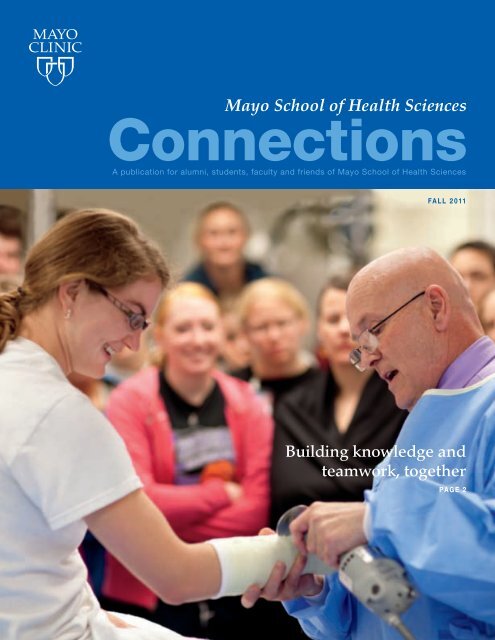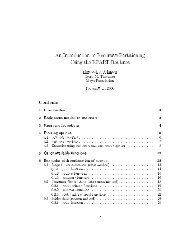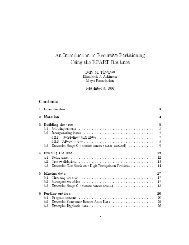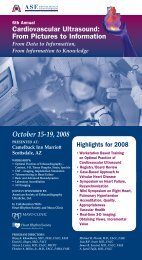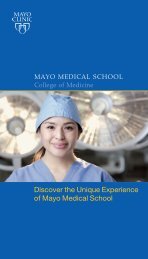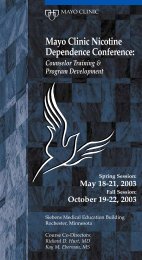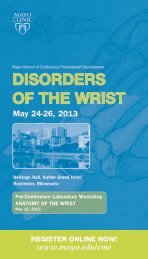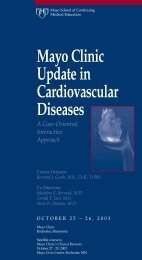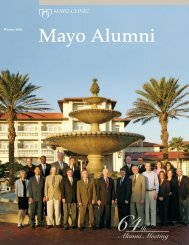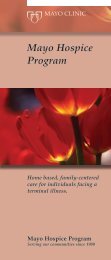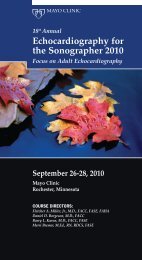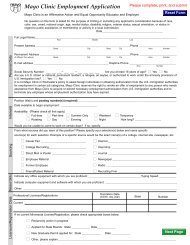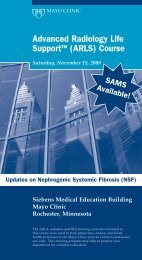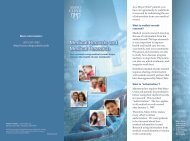MSHS Alumni Connections Mag Fall 2011 - MC4192 ... - Mayo Clinic
MSHS Alumni Connections Mag Fall 2011 - MC4192 ... - Mayo Clinic
MSHS Alumni Connections Mag Fall 2011 - MC4192 ... - Mayo Clinic
You also want an ePaper? Increase the reach of your titles
YUMPU automatically turns print PDFs into web optimized ePapers that Google loves.
<strong>Connections</strong><br />
<strong>Mayo</strong> School of Health Sciences<br />
A publication for alumni, students, faculty and friends of <strong>Mayo</strong> School of Health Sciences<br />
<strong>Fall</strong> <strong>2011</strong><br />
Building knowledge and<br />
teamwork, together<br />
Page 2
Title<br />
Finding ways to connect<br />
i<br />
’m not one for drama but this is true — <strong>Mayo</strong><br />
<strong>Clinic</strong> changed my life. I never considered<br />
<strong>Mayo</strong> as just a school but as a place I needed to<br />
be, to be the best I can be.<br />
When I completed my studies at <strong>Mayo</strong> School of<br />
Health Sciences, I took away much more than my<br />
academic learning. My career has been shaped by<br />
the compassion I saw there and the bonds formed<br />
with other students, staff, teachers and alumni.<br />
I’m a Radiography Program graduate (2000). I<br />
worked at <strong>Mayo</strong> <strong>Clinic</strong> for a year after graduation<br />
then enrolled in the Radiation Therapy Program<br />
(2002). That solid learning has allowed me to<br />
find great employment. My first employment<br />
adventure away from <strong>Mayo</strong> resulted in a move<br />
to MD Anderson Cancer Center, but the Houston<br />
temperatures had me<br />
yearning for clouds. I’ve<br />
been at the Seattle Cancer<br />
Center Alliance for almost<br />
six years.<br />
It’s amazing where<br />
our <strong>Mayo</strong> foundation can<br />
take us. Consider Ron<br />
Caulk, recognized by<br />
the <strong>Alumni</strong> Association<br />
for his outstanding<br />
contributions to his field.<br />
He helped launch an<br />
international organization<br />
for nurse anesthetists and<br />
has literally traveled the<br />
world. (Read about Ron’s<br />
remarkable career on<br />
page 4.)<br />
Where has your career taken you? Which way<br />
would you like your career to grow? Chances are,<br />
there are <strong>MSHS</strong> alumni who have traveled a similar<br />
path and could offer some insights or contacts.<br />
As the new president of the <strong>MSHS</strong> <strong>Alumni</strong><br />
Association, I hope we can all learn from each<br />
other and find more ways to connect. Just as each<br />
one of you has made a commitment to providing<br />
excellence in the medical community, the <strong>MSHS</strong><br />
<strong>Alumni</strong> Association strives to provide excellent<br />
support and information to all of you. The<br />
<strong>Alumni</strong> Association can be a catalyst to make<br />
lifelong connections. Over the years, the <strong>Alumni</strong><br />
Association has helped meet the needs of our<br />
alumni and our community, and we’re always<br />
open to finding new ways to serve you.<br />
Whether you are new graduates or longtime<br />
alumni, the <strong>Alumni</strong> Association board members<br />
would like to hear your ideas to make this<br />
organization more useful and tangible to you.<br />
Your suggestions will make it happen.<br />
Check out the <strong>Alumni</strong> Association website<br />
at www.mayo.edu/alumni.<br />
A Facebook fan? <strong>MSHS</strong> has a page.<br />
Email to mshsaa@mayo.edu.<br />
And yes, we take phone calls, too, at<br />
507-284-2317. C<br />
Jerrod Ernst, president<br />
<strong>Mayo</strong> School of Health Sciences <strong>Alumni</strong> Association<br />
ON THe<br />
COVeR:<br />
Robert Adams, director of the Physician Assistant (PA) Program,<br />
demonstrates how to remove a cast during a casting and suturing<br />
workshop for students in the Physician Assistant and Nurse Practitioner<br />
Programs. His “patient” is Kirsten Dier, student in the PA program.
FALL <strong>2011</strong><br />
<strong>Mayo</strong> School of Health Sciences<br />
<strong>Connections</strong><br />
a publication for alumni, students, faculty and friends of <strong>Mayo</strong> school of Health sciences<br />
13<br />
Grocery store dietitian<br />
Brenton Lexvold dishes out<br />
healthy advice for shoppers<br />
in Rochester, Minn.<br />
2 NP-PA mixer<br />
Learning suturing, casting together<br />
4 Outstanding alumni<br />
honoree<br />
Nurse anesthetist Ron Caulk’s<br />
global calling<br />
6 <strong>Alumni</strong> all together<br />
Recap of the <strong>2011</strong> <strong>Alumni</strong><br />
Association meeting<br />
10 Faith, hope, stress<br />
management<br />
Resilience training helps<br />
on and off the job<br />
12 First-year pharmacist<br />
Doing it all — patient care,<br />
research, education<br />
14 Sonographer trio<br />
Career paths beyond <strong>Mayo</strong> <strong>Clinic</strong><br />
18<br />
Research mentor<br />
Students benefit from<br />
expert guidance<br />
8 Professionalism 101<br />
New course on<br />
workplace values<br />
15 loving memory<br />
Scholarship honors Carolyn Coco<br />
16 Student research<br />
In-depth look at<br />
award-winning study<br />
19 A place to call home<br />
Working to end youth homelessness<br />
20 In the news<br />
Bringing bingo to cancer patients;<br />
second graders check out<br />
Radiography; awards, recognitions
Building knowledge and teamwork, together<br />
Collaboration among programs gives students opportunities<br />
to learn with — and from — each other<br />
teamwork has always been<br />
a hallmark of <strong>Mayo</strong> <strong>Clinic</strong>.<br />
<strong>Mayo</strong>’s multidisciplinary practice is<br />
designed to ensure that health care<br />
professionals from many areas of<br />
expertise can come together to meet<br />
patients’ needs.<br />
But historically, health care<br />
providers have, for the most part,<br />
been trained in isolation from one<br />
another. Doctors attend medical<br />
school. Nurses go to nursing school.<br />
Allied health professionals are<br />
enrolled in specialized programs.<br />
<strong>Mayo</strong> School of Health Sciences<br />
(<strong>MSHS</strong>) is working to change that<br />
teaching model.<br />
To foster communication and<br />
teamwork, students from different<br />
disciplines are learning side by<br />
side and, in the process, gaining a<br />
better appreciation of one another’s<br />
backgrounds and strengths.<br />
Common goals<br />
“The students we’re teaching today<br />
are going to work in team settings<br />
tomorrow,” says Robert Adams,<br />
director of the <strong>MSHS</strong> Physician<br />
Assistant Program. “They will<br />
be part of groups made up of<br />
physicians, nurse practitioners and<br />
physician assistants, among others,<br />
working together for the benefit of<br />
patient care. We work in integrated<br />
practices, so the idea of collaborative,<br />
integrated training just makes sense.”<br />
To give students the experience<br />
of integrated training, <strong>MSHS</strong> has<br />
initiated workshops, simulation<br />
training and classes that include<br />
learners from across the spectrum<br />
of care. For example, physician<br />
assistants (PAs) and nurse<br />
practitioners (NPs) collaborate in<br />
a suturing and casting workshop<br />
(see page 3) and learn together in a<br />
radiology course. Alongside internal<br />
and critical care medicine residents,<br />
NPs receive training at <strong>Mayo</strong> <strong>Clinic</strong>’s<br />
Multidisciplinary Simulation Center<br />
2<br />
<strong>MSHS</strong> CONNECTIONS | FAll <strong>2011</strong>
LEFT: Robert Adams, Physician Assistant<br />
Program director, (center) and Claudia<br />
Swanton, Nurse Practitioner Program<br />
director (far right), instruct NP student<br />
Richard Mokua on casting. His “patient”<br />
is PA student Kristine Jensen.<br />
on central venous catheter placement,<br />
airway management and intubation.<br />
“Collaborative training is<br />
important because it shows students<br />
that even though they may come<br />
from different learning models<br />
and diverse backgrounds, they’re<br />
all working with the same goal<br />
in mind: to provide the best care<br />
and outcomes for patients,” says<br />
Claudia Swanton, director of the<br />
<strong>MSHS</strong> Nurse Practitioner <strong>Clinic</strong>al<br />
Residency Program.<br />
Shared benefits<br />
Students aren’t the only beneficiaries<br />
of collaborative learning. As an<br />
instructor for the casting and suturing<br />
workshop, as well as the integrated<br />
radiology course, Adams sees<br />
advantages for faculty, too.<br />
“I’m excited to teach this way<br />
because participants from different<br />
areas come with a variety of<br />
perspectives on the topics,” he says.<br />
“From an instructor’s standpoint,<br />
differing viewpoints foster a more<br />
robust learning environment.”<br />
In addition, integrated courses<br />
provide a cost advantage. In the past,<br />
providing two separate casting and<br />
suturing workshops for NPs and<br />
PAs cost <strong>MSHS</strong> $3,820. Expenses<br />
associated with the combined<br />
workshop in 2010 were $1,960.<br />
Given the benefits of collaborative<br />
education, <strong>MSHS</strong> plans to expand<br />
this model of learning.<br />
“The more rapport, collegiality<br />
and understanding we can build<br />
between health care professionals,<br />
the better,” says Swanton. C<br />
NPs, PAs join to learn casting, suturing<br />
Mastery of casting and suturing is a must for all NPs and PAs. So a workshop<br />
focusing on these basic skills is nothing new. But in 2010, <strong>MSHS</strong> added a<br />
novel twist. Instead of separate workshops for NPs and PAs, the school<br />
combined the groups and paired them up to learn together.<br />
“NPs and PAs typically come from different perspectives and educational<br />
approaches,” says Claudia Swanton, director of the <strong>MSHS</strong> Nurse Practitioner<br />
<strong>Clinic</strong>al Residency Program. “NPs often come out of a nursing tradition,<br />
while PAs usually have more of a medical model of care. But because NPs<br />
and PAs often work together collegially, it’s important to expose them during<br />
their training to collaboration with one another.”<br />
This seemed like a sensible approach to Danielle VandeBerg, a <strong>2011</strong><br />
graduate of the <strong>MSHS</strong> Physician Assistant Program, who participated<br />
in the casting and suturing workshop. “It was a two-in-one learning<br />
experience,” says VandeBerg. “Suturing and casting are bread-and-butter<br />
skills we all need. But the bonus was getting a chance to talk with each<br />
other, learn about the different programs, and find out about one another’s<br />
backgrounds and goals. That really made it a rich experience and reinforced<br />
the value of teamwork at <strong>Mayo</strong> <strong>Clinic</strong>.”<br />
For Shanna Anderson, a <strong>2011</strong> nurse practitioner graduate who also<br />
participated in the workshop, the uniqueness of the experience made<br />
an impression. “This isn’t an opportunity we would get through an<br />
NP program alone,” she says. “learning with the PAs, we all had an<br />
opportunity to gain understanding and appreciation for one another that<br />
we couldn’t get anywhere else in our training. We have the same goals.<br />
We often work together. We should understand each other.”<br />
Robert Adams, director of the Physician Assistant Program, checks a cast application on<br />
PA student Kirsten Dier.<br />
FAll <strong>2011</strong> | <strong>MSHS</strong> CONNECTIONS 3
<strong>MSHS</strong> outstanding alumnus<br />
Ron Caulk: Advancing nurse<br />
anesthetists around the globe<br />
The <strong>Mayo</strong> School of Health<br />
Sciences Recognition of<br />
Outstanding Contribution<br />
award honors alumni<br />
of <strong>MSHS</strong> programs<br />
whose contributions are<br />
exceptional in one or more<br />
of the following areas:<br />
clinical care, research,<br />
mentoring and education,<br />
or humanitarian endeavors.<br />
This year’s recipient is Ron<br />
Caulk, Nurse Anesthesia<br />
Program, 1962, who served<br />
as executive director of the<br />
International Federation of<br />
Nurse Anesthetists prior<br />
to his retirement in 2004.<br />
Ron Caulk’s positions as president<br />
and executive director of the<br />
International Federation of Nurse<br />
Anesthetists took him around the<br />
world. But his passion for the field<br />
began in his own backyard.<br />
“Growing up, one of our neighbors<br />
was a nurse anesthetist and that<br />
sparked my interest,” says Caulk,<br />
who began working at Mercy<br />
Hospital in Des Moines, Iowa, when<br />
he was 15 years old.<br />
“I started running the elevator<br />
on weekends and became a surgical<br />
technician by the time I graduated<br />
high school,” he says. When word<br />
leaked that Caulk was applying to<br />
nursing school, he was encouraged to<br />
apply to the Mercy Hospital School<br />
of Nursing — even though the school<br />
had never enrolled a male student.<br />
Caulk became the first and was the<br />
sole man among 60-some classmates.<br />
“It was a lot of fun,” he says of his<br />
experience as a trailblazer.<br />
At Mercy, Caulk met a<br />
neurosurgeon who had completed<br />
his fellowship at <strong>Mayo</strong> <strong>Clinic</strong> and<br />
encouraged him to apply to <strong>Mayo</strong>’s<br />
nurse anesthesia training program.<br />
Caulk did and was accepted. “<strong>Mayo</strong><br />
had such a good reputation, and I<br />
knew I would have opportunities<br />
for experiences there that I wouldn’t<br />
have elsewhere,” he says. “I also<br />
knew the institution’s reputation<br />
would open doors. The words ‘<strong>Mayo</strong><br />
<strong>Clinic</strong>’ were like two magic words.<br />
And they still are.”<br />
After graduation, Caulk worked<br />
for two years as the sole anesthesia<br />
provider at Sacred Heart Hospital<br />
in Fort Madison, Iowa. He then<br />
became the chief nurse anesthetist<br />
and director of nursing service at<br />
Hoemako Cooperative Hospital<br />
in Casa Grande, Ariz. His last<br />
position in Arizona was as a staff<br />
nurse anesthetist at the Veterans<br />
Administration Hospital in Phoenix,<br />
Ariz., where he practiced for 12 years.<br />
Advocate for nurse anesthetists<br />
While in Arizona, Caulk began<br />
his career-long involvement in<br />
professional organizations.<br />
“I always knew I wanted to be<br />
involved in my profession,” he<br />
says. “I felt I needed to become an<br />
advocate for nurse anesthetists.”<br />
Caulk became a member of<br />
the Arizona Association of Nurse<br />
Anesthetists, serving on various<br />
committees before becoming president<br />
in 1968. His leadership in the Arizona<br />
organization led to positions in the<br />
American Association of Nurse<br />
Anesthetists (AANA). He was elected<br />
president of that organization in 1977.<br />
Following his AANA presidency,<br />
Caulk followed his heart and<br />
returned to the Midwest.<br />
“I fell in love with a nurse<br />
anesthetist and moved to Chicago<br />
to be with her,” he says. That nurse<br />
anesthetist became his wife, Susan,<br />
who was the director of continuing<br />
education, certification and<br />
4<br />
<strong>MSHS</strong> CONNECTIONS | <strong>Fall</strong> <strong>2011</strong>
ecertification for the AANA until her<br />
retirement in 2006.<br />
In Illinois, Caulk was assistant<br />
director of surgery and allied services<br />
at St. Francis Hospital in Peoria, and<br />
taught clinical anesthesia courses at<br />
Northwestern University Hospital.<br />
He also continued his involvement<br />
with the AANA and served as<br />
the organization’s representative<br />
to a planning committee for an<br />
international symposium of nurse<br />
anesthetists.<br />
This would become a defining<br />
appointment for Caulk and the<br />
profession. After the success of the<br />
first International Symposium for<br />
Nurse Anesthetists, held in 1985 in<br />
Lucerne, Switzerland, many members<br />
of the planning committee were<br />
eager to establish an international<br />
organization. Caulk had reservations<br />
about the endeavor.<br />
“I had my doubts about whether<br />
an international organization would<br />
fly,” he says. “The language barrier<br />
alone made planning extraordinarily<br />
difficult.”<br />
The AANA urged Caulk to<br />
survey the international community<br />
to determine a direction for the<br />
“Mr. Caulk’s visit was a revelation<br />
to the scope of practice in the<br />
United States, which was beyond<br />
what I was accustomed to.”<br />
potential organization. The results<br />
revealed a remarkably uniform set<br />
of goals: international standards<br />
for clinical practice and anesthesia<br />
education, educational opportunities<br />
and international recognition.<br />
This unity of purpose convinced<br />
Caulk that an international<br />
organization had value, and he<br />
devoted an increasing amount of time<br />
and energy to the fledgling group.<br />
In 1989, the International Federation<br />
of Nurse Anesthetists (IFNA) was<br />
officially established, with Caulk as<br />
its first vice president. He assumed<br />
the presidency the following year and<br />
held the position until 1995, when he<br />
was named the organization’s first<br />
executive director.<br />
The organization saw tremendous<br />
growth under Caulk’s watch.<br />
“The IFNA began with 11 national<br />
nurse anesthesia organizations and<br />
today it has more than 40 national<br />
nurse anesthesia organizations as<br />
members,” he says.<br />
From Ghana to <strong>MSHS</strong><br />
Caulk traveled extensively in his roles<br />
with IFNA, helping to raise awareness<br />
of the profession worldwide. His<br />
travels also helped broaden the<br />
horizons of many nurse anesthetists.<br />
Marian Kwansa was one of them.<br />
Whether caring for patients, advancing the<br />
role of nurse anesthetists around the globe<br />
or learning about Native American cultures,<br />
Ron Caulk’s focus has been the same.<br />
“It’s all about the people, the relationships,”<br />
he says. “That’s what’s most rewarding.”<br />
—Marian Kwansa<br />
Kwansa, a graduate of the <strong>Mayo</strong><br />
School of Health Sciences nurse<br />
anesthesia program and a nurse<br />
anesthetist at <strong>Mayo</strong> <strong>Clinic</strong>, first heard<br />
Caulk speak as a student at the only<br />
nurse anesthesia program in her<br />
native Ghana. He later wrote a letter<br />
of recommendation to accompany her<br />
application to graduate school.<br />
“Mr. Caulk’s visit was a revelation<br />
to the scope of practice in the United<br />
States, which was beyond what I was<br />
accustomed to,” she says. “His visit<br />
made all the nurse anesthetists in<br />
Ghana aware of the practice in other<br />
parts of the world, which started<br />
us doing educational networking<br />
internationally and enhanced our<br />
scope of practice.”<br />
When Caulk visited the Ghanaian<br />
school that Kwansa attended, he<br />
brought some textbooks as a gift. The<br />
school’s response overwhelmed him.<br />
“They had only one textbook for<br />
the entire school,” says Caulk. “The<br />
textbooks I brought were like gold<br />
coins.” The discovery prompted Caulk<br />
to initiate a used textbook donation<br />
program through the IFNA, which has<br />
sent much-needed textbooks to Israel,<br />
Palestine, Cambodia and numerous<br />
African countries.<br />
In 2004, Caulk retired from the<br />
IFNA. He and Susan moved back to<br />
Arizona, where they’ve become active<br />
volunteers for the Heard Museum,<br />
which is dedicated to Native North<br />
American cultures and art.<br />
“It’s a lot of fun to be doing<br />
something new,” says Caulk. “I work<br />
in the gift shop and get to meet the<br />
artists when they bring their art in to<br />
sell. I love it.” C<br />
<strong>Fall</strong> <strong>2011</strong> | <strong>MSHS</strong> CONNECTIONS 5
<strong>Alumni</strong> all together<br />
In April, alumni representing<br />
many programs gathered in<br />
Rochester for the annual <strong>MSHS</strong><br />
<strong>Alumni</strong> Association meeting and<br />
dinner. It was an evening of great<br />
conversation — about <strong>MSHS</strong>, career<br />
paths, jobs and healthy living.<br />
1<br />
1. Physical Therapy Program alumni were well<br />
represented. Left to right are: Brian Schreck,<br />
Brad King, Kathy Benke, Jan Maass, LeRae<br />
Miller, Gayle Sanderson, Bart Hanson, Andy<br />
Wood, Jim Williams and Brad Wehe.<br />
2. Kathy Sagdalen (Medical Laboratory<br />
Technician, 1997) and her husband, Jeff.<br />
3. Keynote speakers John Schulz, MD, and<br />
Dieter Heinz, MD, physicians at <strong>Mayo</strong> <strong>Clinic</strong><br />
Health System in Albert Lea, discussed results<br />
of a yearlong community experiment in healthy<br />
living in their community.<br />
4. Julia Voung (<strong>Clinic</strong>al Laboratory Sciences,<br />
1993) and her husband, Michael.<br />
2 3<br />
5. Lynn Borkenhagen (Nurse Practitioner,<br />
1998) and her husband, John.<br />
6. Scott Fedraw (<strong>Clinic</strong>al Neurophysiology<br />
Technology, 1995) and his wife, Leslie.<br />
7. Jennie Goble (Physical Therapy, 2010) and<br />
her husband, Tony.<br />
8. Carolyn Heyne (Physical Therapy, 1967)<br />
and her husband, George.<br />
4<br />
9. <strong>MSHS</strong> <strong>Alumni</strong> Association board members,<br />
left to right, Natalie Loeffler, Vanessa Scifres,<br />
Amy Fauri and Michelle Wilt.<br />
10. Minerva Johnson (Nurse Anesthetist,<br />
2005) and her husband, Dan.<br />
6<br />
<strong>MSHS</strong> CONNECTIONS | <strong>Fall</strong> <strong>2011</strong>
5 6 7<br />
8<br />
9 10<br />
FAll <strong>2011</strong> | <strong>MSHS</strong> CONNECTIONS 7
Professionalism 101<br />
<strong>MSHS</strong> adds all-school seminar to teach workplace values<br />
there’s a new learning requirement<br />
for all <strong>Mayo</strong> School of Health<br />
Sciences (<strong>MSHS</strong>) students:<br />
professionalism.<br />
“It’s not good enough to learn<br />
professionalism on the job,” says<br />
Michael Silber, MB, ChB, <strong>MSHS</strong><br />
associate dean for academic and<br />
faculty affairs, who helped develop<br />
the curriculum. “We want our<br />
students to learn these values before<br />
they start work.”<br />
Since 2010, <strong>MSHS</strong> has required<br />
students to participate in a one-time<br />
professionalism seminar. Students<br />
from all <strong>MSHS</strong> programs gather<br />
and then meet in cross-disciplinary<br />
small groups to discuss scenarios<br />
that touch on patient confidentiality,<br />
compassion, honesty, commitment<br />
to excellence and other aspects of<br />
professionalism.<br />
<strong>Mayo</strong> <strong>Clinic</strong>’s view of<br />
professionalism is broad, says<br />
Dr. Silber, encompassing all<br />
interactions with patients and<br />
their families, staff, colleagues and<br />
other students.<br />
While some of the attributes<br />
seem like commonsense, others are<br />
more complex. Dr. Silber says that<br />
complexity is why the seminar uses<br />
group discussions to encourage<br />
students to share experiences and<br />
viewpoints. Each group discussion is<br />
facilitated by a program director, an<br />
administrator or a faculty member.<br />
The format has earned good<br />
reviews. “Most of us are well aware<br />
of what professionalism entails,”<br />
says Dr. Silber. Even so, more<br />
than 70 percent of participants<br />
noted in a survey that both smallgroup<br />
discussions and scenarios<br />
improved their understanding of<br />
professionalism.<br />
The seminar is the first <strong>MSHS</strong><br />
course ever required for all<br />
students, regardless of program.<br />
“We’re committed to teaching<br />
professionalism and teamwork,”<br />
he says. “It’s just as important as<br />
teaching technical skills.”<br />
“ I felt very comfortable<br />
talking about ethical<br />
issues with the small<br />
group. I didn’t feel<br />
as though I would<br />
be judged.”<br />
—sTUDEnT ParTiCiPanT<br />
8<br />
<strong>MSHS</strong> CONNECTIONS | FAll <strong>2011</strong>
Caution: Unprofessional meeting in progress<br />
The program director has scheduled<br />
a team meeting to review progress<br />
for a recently assigned team project.<br />
looking around the conference table,<br />
the program director notices:<br />
• Jill Chillin is slumping in her<br />
chair, with her legs stretched and<br />
crossed at the feet.<br />
• Phil Phone, who is absorbed<br />
sending text messages on his phone.<br />
• Susie Crossarms has her arms<br />
folded across her chest and is<br />
intently looking at the presenter.<br />
sitting erect in her chair with her<br />
feet on the floor, actively listening,<br />
nodding her head to illustrate<br />
understanding. Gloria speaks up,<br />
saying, “like Dude, my BFF and<br />
I feel this team has like worked<br />
really good (she laughs) and like<br />
we completed our team goal.”<br />
What professionalism faux pas are<br />
students showing? What actions should<br />
the program director take?<br />
• Cathy Chattie and Nancy Nosy<br />
are talking about a topic not<br />
related to the issue at hand.<br />
• Howard Hungry is sitting on the<br />
edge of his chair with his legs<br />
spread and elbows propped on his<br />
knees while eating a bag of chips.<br />
Eager Howard speaks up, spewing<br />
pieces of chips across the table.<br />
• Gloria Good arrives to the<br />
meeting early, well prepared to<br />
discuss the team project. Gloria is<br />
scenaRIOs sPaRK dIscussIOn<br />
This unfortunate meeting is one of<br />
more than a dozen scenarios that are<br />
part of the professional curriculum.<br />
“This one is a bit exaggerated,”<br />
says Troy Tynsky, <strong>MSHS</strong> operations<br />
manager and a course facilitator. “For<br />
the most part, the scenarios are so<br />
real, so plausible, that it is very likely<br />
that every one of us will see them<br />
play out.”<br />
Other scenarios include:<br />
• Students, celebrating the end of<br />
final exams, get rowdy in a bar.<br />
• A student continues to dress<br />
unprofessionally, even after<br />
reminders from a preceptor.<br />
• An employee is offered sporting<br />
event tickets from a vendor.<br />
• A colleague complains about a<br />
female patient’s request for an<br />
exam by a female provider.<br />
• A student believes a peer has<br />
lied about the reason for a<br />
school absence.<br />
• Without naming the patient,<br />
colleagues discuss the patient’s care<br />
in a staff area.<br />
Context and answers are provided<br />
for each scenario. “But the answers<br />
aren’t always absolute,” says Tynsky.<br />
“This course isn’t about memorizing<br />
the correct answers,” he says. “We<br />
hope the discussions provide students<br />
with a framework to make good<br />
decisions in complex situations.” C<br />
FAll <strong>2011</strong> | <strong>MSHS</strong> CONNECTIONS 9
Faith, hope and stress management<br />
Hospital chaplains aren’t immune<br />
to stress that can weigh on the<br />
soul and interfere with their efforts to<br />
comfort others.<br />
To help remedy that human frailty,<br />
six <strong>Clinic</strong>al Pastoral residents attended<br />
an all-day workshop in March to<br />
build resilience — their ability to<br />
withstand and bounce back from<br />
adversity. Presented by <strong>Mayo</strong> <strong>Clinic</strong>’s<br />
Complementary and Integrative<br />
Medicine (CIM) Program, the Stress<br />
Management and Resilience Training<br />
(SMART) workshop offers strategies<br />
to help participants in their personal<br />
lives and on the job.<br />
Science of resilience<br />
“A lot of stress is involuntary,” says<br />
Amit Sood, MD, who developed the<br />
SMART workshop. He’s director<br />
of research and practice of the CIM<br />
Program and chair of the <strong>Mayo</strong><br />
Mind Body Initiative, which explores<br />
wellness-promoting activities for the<br />
body, mind, and spirit. “It’s ingrained<br />
in biological mechanisms.”<br />
The brain’s chemical responses<br />
are unable to distinguish between<br />
real and imagined danger, and<br />
respond defensively to modern<br />
threats that are largely the product<br />
of worry, explains Dr. Sood. These<br />
stresses engage the brain’s limbic<br />
system and cause people to spend<br />
excessive time thinking about the<br />
past and future. As a result, says Dr.<br />
Sood, performance and relationships<br />
suffer, stress escalates, and the risk of<br />
assorted health problems rises.<br />
Science-based SMART techniques<br />
enhance resilience and reduce<br />
stress, allowing the brain to focus<br />
on the moment. (See SMART ways<br />
to de-stress.) “Applying simple<br />
techniques, people can be more<br />
effective pastors, more compassionate<br />
to themselves, their families and the<br />
patients they visit,” says Dr. Sood.<br />
Roger Ring, <strong>Clinic</strong>al Pastoral<br />
Education (CPE) program director,<br />
attended a SMART session as part of<br />
staff training and immediately saw it<br />
could benefit CPE residents. “I hoped<br />
they would gain serenity and the<br />
ability to stay in the present moment,<br />
emotionally and spiritually,” Ring says.<br />
Living with more compassion<br />
The CPE residents agree that SMART<br />
tools are helpful, personally and<br />
professionally. After practicing the<br />
SMART program for six weeks,<br />
chaplain resident Kyle Haack<br />
committed to another six weeks.<br />
“I found it very inspiring,” Haack<br />
says. “I did find myself changed by<br />
it.” For example, he began silently<br />
blessing bad drivers on his daily<br />
commute. “It changed my perspective<br />
on the people I encountered.”<br />
Chaplain resident Betty McManus<br />
gave the SMART program an eightweek<br />
trial. Finding that it aligns with<br />
her belief in the relationship between<br />
Left to right, Betty McManus, Kyle Haack,<br />
both <strong>Clinic</strong>al Pastoral Education (CPE)<br />
interns, say they have benefited from their<br />
new stress management skills. Roger Ring,<br />
CPE program director, recently scheduled the<br />
workshop for CPE interns.<br />
10 <strong>MSHS</strong> CONNECTIONS | FAll <strong>2011</strong>
SMART ways to de-stress<br />
Perception — a person’s view of daily interactions — directly impacts<br />
resilience, says Amit Sood, MD, director of research and practice of <strong>Mayo</strong><br />
<strong>Clinic</strong>’s Complementary and Integrative Medicine Program and chair of the<br />
<strong>Mayo</strong> Mind Body Initiative.<br />
During the Stress Management and Resilience Training (SMART) workshop,<br />
Dr. Sood teaches people to strengthen their resilience and well-being with tools<br />
that enhance the two key elements of perception: attention and interpretation.<br />
Attention<br />
Research studies suggest that humans instinctively focus on threat and<br />
imperfections. SMART helps achieve attention that is focused, relaxed,<br />
balanced, nonjudgmental and in the present moment.<br />
Amit Sood, MD, developed the Stress<br />
Management and Resilience Training<br />
(SMART) workshop.<br />
ministry and self-care, she plans to<br />
continue using it.<br />
Joyful attention, the daily habit<br />
of paying close attention to details<br />
in nature, has given McManus an<br />
effective way to alleviate stress. “It<br />
reminds me to be in wonder about<br />
the beauty that exists in our lives.<br />
Why hang on to stress and anxiety? If<br />
I intentionally focus on that beauty, I<br />
feel grounded and find a much better<br />
inner peace.”<br />
SMART recently helped McManus<br />
respond to the needs of a mother<br />
who had just learned her child has a<br />
terminal illness.<br />
“Paying kind, passionate attention<br />
to her grief helped me connect to her<br />
in ways that I hadn’t been able to<br />
before,” McManus says. “She grabbed<br />
me and hugged me. I let her rest in<br />
the love I was trying to give to her.”<br />
McManus is convinced that<br />
resilience will be invaluable in her<br />
career as a hospital or hospice chaplain.<br />
“A chaplain is usually there to uplift<br />
spirits or be a companion in pain,” she<br />
says. “You’re exposed to situations that<br />
are quite devastating — stage IV cancer<br />
and people entering hospice. These<br />
new habits will help me stay buoyant<br />
so I can minister to others.” C<br />
Tool 1: Joyful attention. Use your senses to be fully aware in the moment.<br />
Spend time with nature. Find one new detail in your surroundings or the<br />
people you meet — at least four times a day.<br />
Tool 2: Kind attention. Transform daily encounters by silently saying a kind<br />
thought or blessing for at least 20 people a day, especially when you sense<br />
an emotional response.<br />
Interpretation<br />
Interpretation is the human tendency to read something extra into reality.<br />
Stress causes a person to interpret an innocent comment or gesture as<br />
distrust or an insult, for example, and to react emotionally to the perceived<br />
threat. SMART helps replace judgmental and reactive tendencies with a<br />
calm, flexible disposition.<br />
Tool 3: Daily themes. Use an anchoring outlook to interpret experiences,<br />
especially those with an element of stress.<br />
day tHeme eXamPle<br />
Monday<br />
Gratitude<br />
i am grateful for the opportunities in<br />
each challenge.<br />
Tuesday Compassion i have compassion for each person i encounter.<br />
Wednesday<br />
Thursday<br />
acceptance<br />
Meaning and<br />
purpose<br />
i accept what is beyond control in myself,<br />
others and situations.<br />
i live this day with higher meaning,<br />
focused on service and love.<br />
Friday Forgiveness i forgive myself and others.<br />
Saturday Celebration i celebrate the good things in my life.<br />
Sunday<br />
reflection<br />
and prayer<br />
i think about the higher principles that<br />
guide my life.<br />
FAll <strong>2011</strong> | <strong>MSHS</strong> CONNECTIONS 11
Alumnus profile<br />
Pharmacist finds his niche in practice,<br />
research and education<br />
as a first-year, second-generation<br />
pharmacist, Daniel Jackson,<br />
PharmD, BCPS, is living his passion.<br />
Jackson completed a one-year<br />
Critical Care Specialty Pharmacy<br />
residency at <strong>Mayo</strong> School of Health<br />
Sciences (<strong>MSHS</strong>) in Florida in<br />
2010. He’d already completed a<br />
yearlong General Pharmacy Practice<br />
residency at Shands Jacksonville<br />
at the University of Florida Health<br />
Science Center. For the last year, he<br />
has been a hospital pharmacist at<br />
<strong>Mayo</strong> <strong>Clinic</strong>’s Florida campus and<br />
recently transferred to a critical care<br />
pharmacist position.<br />
“It’s more of a passion than a job,”<br />
he says. “I provide pharmaceutical<br />
care for patients in the hospital.” He<br />
also precepts pharmacy students and<br />
rotating residents, and is engaged<br />
in research. “My interest in research<br />
grew after being at <strong>Mayo</strong> <strong>Clinic</strong>. I<br />
like being involved in trying new<br />
things to enhance therapy for certain<br />
patient populations.” Jackson works<br />
on research involving intensive care<br />
patients with hemorrhagic stroke.<br />
For Jackson, teaching is just as<br />
compelling as research. “I like the<br />
atmosphere and opportunities at a<br />
teaching hospital,” he says.<br />
Jackson says he is grateful for the<br />
time others spent with him when he<br />
was a resident and eagerly gives<br />
back. “When you transition from<br />
student to resident, you’re<br />
dependent on others to show you<br />
the ropes,” he says. “The outcomes<br />
of a residency are proportional to<br />
the time and dedication the resident<br />
puts in. I want to help them<br />
succeed, so if I am working with<br />
residents, I don’t leave until their<br />
questions are answered.”<br />
Jackson comes by the profession<br />
and dedication naturally. His father,<br />
Ken Jackson, RPh, owns a community<br />
Daniel Jackson, PharmD, BCPS, is a<br />
critical care pharmacist on <strong>Mayo</strong> <strong>Clinic</strong>’s<br />
Florida campus.<br />
“ I like the atmosphere<br />
and opportunities at a<br />
teaching hospital.”<br />
—DaniEL JaCKsOn<br />
pharmacy in Fort Pierce, Fla. “I saw<br />
my dad pour himself into helping<br />
people in his role as a pharmacist,”<br />
says Jackson. “He has a strong work<br />
ethic and was a role model for me.”<br />
Jamila Russeau, PharmD, BCPS,<br />
coordinator, <strong>MSHS</strong> Pharmacy<br />
Residency Program in Florida,<br />
commends Jackson’s dedication to<br />
the profession. “Before he completed<br />
his residency, he’d already talked to<br />
me about precepting residents and<br />
students,” she says.<br />
He already provides an example of<br />
what we want residents to do when<br />
they complete our program, says<br />
Russeau. He’s an active member of<br />
the Education Advisory Committee<br />
and resident selection process.<br />
“Our residents often mention<br />
that he guides them and helps with<br />
their projects.”<br />
Jackson considers himself<br />
fortunate to begin his practice at<br />
<strong>Mayo</strong> <strong>Clinic</strong>. “I knew this was<br />
where I wanted to work, and my<br />
residency made me confident in my<br />
ability to care for patients,” he says.<br />
“<strong>Mayo</strong>’s core values align with the<br />
values I hold as a pharmacist — the<br />
needs of the patient come first, and<br />
a focus on research and education of<br />
future practitioners.” C<br />
12 <strong>MSHS</strong> CONNECTIONS | FAll <strong>2011</strong>
Alumnus profile<br />
Showing shoppers the array<br />
of healthy food choices<br />
making nutritious food purchases<br />
when faced with a supermarket<br />
full of choices can be tough for anyone.<br />
Add in the dietary restrictions that<br />
accompany many medical conditions,<br />
and grocery shopping can become<br />
downright daunting.<br />
That’s where Brenton lexvold’s<br />
expertise can help. A registered<br />
dietitian and graduate of the <strong>Mayo</strong><br />
School of Health Sciences (<strong>MSHS</strong>)<br />
Dietetic Internship, lexvold is the<br />
in-store dietitian at Hy-Vee Barlow<br />
Plaza in Rochester, Minn. He uses his<br />
education and training at <strong>Mayo</strong> <strong>Clinic</strong>,<br />
as well as his background as a chef, to<br />
make smart food choices easier and<br />
more enjoyable for his customers.<br />
“One of the things I like most<br />
about this job is showing people the<br />
possibilities,” says lexvold. “When<br />
someone is used to having freedom<br />
of choice about their diet, and then a<br />
diet restriction becomes necessary, it<br />
can feel like a wall has been placed in<br />
front of them. I help break down that<br />
wall by showing them all the choices<br />
they still have and giving them ideas<br />
on how to prepare foods in ways<br />
they will enjoy. Usually they aren’t as<br />
limited as they may think they are.”<br />
lexvold’s interest in food was<br />
sparked in high school, when he<br />
worked with a chef in Zumbrota,<br />
Minn., close to his hometown of<br />
Mazeppa. After graduation, he went<br />
on to earn his associate’s degree from<br />
le Cordon Bleu Culinary College and<br />
worked as a chef in several restaurants.<br />
Although he enjoyed the work,<br />
he craved more interaction with his<br />
Working for a grocery store, registered dietitian Brenton Lexvold dishes out shopping tips for<br />
customers on restricted diets. A former chef, he also teaches cooking and nutrition classes.<br />
customers. With an eye to increasing<br />
his knowledge of food science,<br />
lexvold decided to go back to school,<br />
enrolling in the dietetics program<br />
at the University of Wisconsin -<br />
Stout in 2006. As he finished his<br />
bachelor’s degree in 2009, he was<br />
drawn to <strong>MSHS</strong>’s Dietetic Internship<br />
in large part because of <strong>Mayo</strong><br />
<strong>Clinic</strong>’s reputation for excellence and<br />
commitment to patients’ needs.<br />
“I felt that <strong>Mayo</strong>’s patient-centered<br />
philosophy of care fit perfectly with<br />
my own outlook,” says lexvold. “I<br />
want to take care of the customers I<br />
work with, first and foremost.”<br />
Now, as a dietitian who interacts<br />
with the public every day, lexvold<br />
uses that approach in a range of<br />
settings. Not only does he offer<br />
personal shopping assistance, lexvold<br />
also teaches cooking and nutrition<br />
classes, offers store tours, conducts<br />
cholesterol and blood pressure<br />
screenings, and makes presentations<br />
to community organizations.<br />
Throughout his work, he keeps his<br />
connections to <strong>MSHS</strong> strong.<br />
“In the work I’m doing now, I can<br />
see a full circle being completed. Many<br />
customers are referred to me by their<br />
clinical dietitians. What they learn<br />
at the clinic, I can help them put into<br />
practice,” says lexvold. “I also use my<br />
preceptors at <strong>Mayo</strong> as a resource. If I<br />
don’t know an answer to a question,<br />
or if I need more information, I often<br />
talk with one of them. It’s a great<br />
partnership within our local health<br />
care community.” C<br />
FAll <strong>2011</strong> | <strong>MSHS</strong> CONNECTIONS 13
<strong>Alumni</strong> profile<br />
Sonographers build careers beyond <strong>Mayo</strong><br />
mayo <strong>Clinic</strong> developed formal<br />
education programs in part to<br />
provide its own supply of well-trained<br />
staff. But <strong>Mayo</strong> School of Health<br />
Sciences (<strong>MSHS</strong>) graduates are in<br />
demand beyond <strong>Mayo</strong> campuses, too.<br />
Eighty miles west of Rochester, three<br />
graduates of the <strong>MSHS</strong> Sonography<br />
Program make up 60 percent of the<br />
ultrasound department at the Mankato<br />
<strong>Clinic</strong>, a regional group practice.<br />
As ultrasound manager, Jana<br />
Hansen, RT(R), RDMS, RVT, has<br />
hired four <strong>MSHS</strong> graduates over the<br />
years, including two currently on<br />
staff, Sara Willaert, RDMS, RVT, and<br />
Bethanie Olson, RDMS, RVT.<br />
“Knowing the program at <strong>MSHS</strong>, I<br />
understand what students are taught<br />
and the expectations they must<br />
meet,” Hansen says. “Their students<br />
get excellent clinical experience. They<br />
really are guided one-on-one through<br />
the program.”<br />
Hansen graduated in 1994 and<br />
was hired to start the ultrasound<br />
department at the Mankato <strong>Clinic</strong>. She<br />
was eager for that kind of challenge.<br />
“I loved the family setting in<br />
Mankato, and I liked knowing the<br />
doctors I was working with,”<br />
says Hansen.<br />
Willaert and her husband grew up<br />
in Mankato. She targeted Mankato<br />
after graduating in 2006 and landed<br />
a job at <strong>Mayo</strong> <strong>Clinic</strong> Health System<br />
in Mankato.<br />
“I hoped for something in the area,<br />
and the hospital was hiring at that<br />
time,” Willaert says. She joined the<br />
Mankato <strong>Clinic</strong> in January 2010.<br />
Olson and her husband are from<br />
St. James, about 40 miles southwest of<br />
Mankato. While attending <strong>MSHS</strong>, she<br />
stayed with a classmate in Rochester<br />
during the week and spent the<br />
weekend in Mankato, where she and<br />
her husband lived. looking to work<br />
somewhere in the Mankato area,<br />
she started at the Mankato <strong>Clinic</strong> in<br />
March 2009.<br />
“I graduated on a Friday and<br />
started the following Tuesday,”<br />
Olson recalls.<br />
All three work at the Mankato<br />
<strong>Clinic</strong>’s main location and believe<br />
that <strong>MSHS</strong> provided high-quality<br />
training marked by <strong>Mayo</strong>’s precise<br />
processes, focus on the patient, and<br />
broad clinical experience.<br />
“<strong>Mayo</strong> was the first and only<br />
school on my list,” Olson says. “I<br />
liked that I was learning and doing<br />
clinicals hand in hand. It was an<br />
amazing experience because of the<br />
big variety. Most days the schedules<br />
were full. There were 60 patients<br />
coming in for ultrasounds.”<br />
Whether they work at <strong>Mayo</strong> <strong>Clinic</strong><br />
or elsewhere, <strong>MSHS</strong> graduates carry<br />
their knowledge with them for the<br />
rest of their careers. C<br />
Left to right, <strong>MSHS</strong> alumni Bethanie Olson,<br />
RDMS, RVT, Jana Hansen, RT(R) RDMS,<br />
RVT, and Sara Willaert, RDMS, RVT, work in<br />
the ultrasound department at Mankato <strong>Clinic</strong>, a<br />
regional group practice in southern Minnesota.<br />
14 <strong>MSHS</strong> CONNECTIONS | FAll <strong>2011</strong>
Husband funds dietetics scholarship<br />
in wife’s memory<br />
after his wife’s death, Salvatore<br />
Coco offered a gift to <strong>Mayo</strong> School<br />
of Health Sciences in her memory.<br />
“Carolyn was very proud of her<br />
time at <strong>Mayo</strong>. It meant a lot to her,”<br />
says Coco. “She often said, ‘I wish<br />
I could take you there and show<br />
you.’ I wish we’d made that trip.<br />
I loved her very much, and I want<br />
to do some things that would have<br />
pleased her.”<br />
Coco donated $20,000 to establish<br />
the Carolyn Harmon Coco Scholarship<br />
to benefit dietetics students. Harmon<br />
Coco completed a yearlong internship<br />
in dietetics at Saint Marys Hospital in<br />
Rochester in 1953.<br />
According to Coco, his wife<br />
talked about the strong leadership<br />
of Sister Mary Brigh and Sister<br />
Mary Victor, and having baby-sat<br />
for the children of Charles “Chuck”<br />
W. <strong>Mayo</strong>, MD, the son of Charles<br />
“Charlie” H. <strong>Mayo</strong>, MD.<br />
“Carolyn once lost the pin she<br />
received when she completed her<br />
internship and was distraught until<br />
she found the pin,” says Coco. “She<br />
went on to accomplish a lot in her<br />
career, but the time she spent at<br />
<strong>Mayo</strong> <strong>Clinic</strong> was a high point. I hope<br />
others who pursue careers in dietetics<br />
benefit from the scholarship, and<br />
treasure their time at <strong>Mayo</strong> <strong>Clinic</strong> as<br />
much as my wife did.”<br />
Originally from Perham, Maine,<br />
Harmon Coco received a bachelor’s<br />
degree in home economics and a<br />
master’s degree in library science<br />
from the University of Maine. She<br />
worked as a high school foods<br />
teacher, a school librarian, and a<br />
clinical dietitian at a hospital, a camp<br />
for diabetic children and several<br />
nursing homes. She was a member of<br />
the American Dietetic Association for<br />
more than 50 years. For the last 18<br />
years of her career, she was a health<br />
science librarian at St. Joseph Hospital<br />
in Bangor, Maine. In his wife’s honor,<br />
Coco made a donation to the library,<br />
which was subsequently dedicated<br />
as the Carolyn Harmon Coco<br />
Medical library.<br />
Salvatore Coco, left, says his wife,<br />
Carolyn Harmon Coco, remembered<br />
her time at <strong>Mayo</strong> <strong>Clinic</strong> as one of the<br />
highlights of her career.<br />
Harmon Coco, who lived in<br />
Brewer, Maine, died on Dec. 23, 2009,<br />
at age 79. She and her husband were<br />
married for 53 years and had two<br />
sons, John and David. C<br />
mayO clInIc dIetetIc InteRnsHIP PROGRam<br />
The <strong>Mayo</strong> <strong>Clinic</strong> Dietetic internship<br />
Program at saint Marys Hospital was<br />
established in 1930 by sister Mary<br />
Victor. The initial class had one intern.<br />
now, eight interns are admitted<br />
each year and nearly 1,200 interns<br />
have completed the program.<br />
In 1933, the program was accredited<br />
by the American Dietetic Association.<br />
The Dietetic Internship Program<br />
became part of <strong>Mayo</strong> School of Health<br />
Sciences in 1995.<br />
Scholarship recipients for <strong>2011</strong>-12<br />
sheri Lingle, ithaca, new York<br />
Tracy reith, Mankato, Minn.<br />
Jana wells, Tekamah, neb.<br />
Hannah Zabel, rochester, Minn.<br />
FAll <strong>2011</strong> | <strong>MSHS</strong> CONNECTIONS 15
Leah Walters<br />
Students as<br />
researchers<br />
Katherine Martin<br />
leah Walters and Katherine<br />
Martin, <strong>2011</strong> graduates of the<br />
<strong>MSHS</strong> Nuclear Medicine Program,<br />
worked together on their awardwinning<br />
study titled “Stability<br />
Evaluation of [ 18 F]FDG at High<br />
Radioactive Concentrations.”<br />
Martin presented their work at<br />
the annual meeting of the Society<br />
of Nuclear Medicine in June in San<br />
Antonio, winning third place overall<br />
in the student research category.<br />
“Even more exciting,” says Martin,<br />
“our research may be put into practice<br />
at <strong>Mayo</strong> <strong>Clinic</strong>.”<br />
“<strong>Mayo</strong> <strong>Clinic</strong> has been approved<br />
by the FDA to make our [ 18 F]FDG<br />
in 500 mCi/ml concentration,”<br />
says Martin. “Making [ 18 F]FDG<br />
in higher concentrations would<br />
allow for less production runs.<br />
This ultimately results in decreased<br />
radiation exposure to the operators,<br />
as well as reducing time, money and<br />
equipment maintenance.”<br />
Martin, of Dodgeville, Wis.,<br />
earned her undergraduate degree in<br />
nuclear medicine technology at the<br />
University of Wisconsin-la Crosse.<br />
Walters, a native of Albert lea,<br />
Minn., earned a bachelor’s degree in<br />
biology at luther College, Decorah,<br />
Iowa. “It was a really great experience<br />
to do research and see nuclear<br />
medicine from another perspective,”<br />
she says. C<br />
Stability Evaluation of [ 18 F]FDG at<br />
High Radioactive Concentrations<br />
Leah Walters, Katherine Martin, Joseph Hung, Mark Jacobson, and Elton Mosman<br />
Division of Nuclear Medicine, Department of Radiology; <strong>Mayo</strong> <strong>Clinic</strong>, Rochester, Minn.<br />
BACKGROUND<br />
Positron emission tomography<br />
(PET) is a commonly used form<br />
of diagnostic imaging within the<br />
medical field. This imaging modality<br />
is becoming progressively more<br />
widely utilized. The most frequently<br />
used radiopharmaceutical is 2-[ 18 F]<br />
fluoro-2-deoxy-D-glucose, or simply<br />
[ 18 F]FDG (Figure 1).<br />
A recent influx of studies employing<br />
the use of [ 18 F]FDG has resulted in the<br />
necessity of producing [ 18 F]FDG in<br />
high radioactive concentrations. This<br />
has created a serious issue, radiolytic<br />
decomposition, that would affect<br />
the amount of time [ 18 F]FDG would<br />
maintain radiochemical stability<br />
Figure 1:<br />
2-[ 18 F]fluoro-2-deoxy-D-glucose<br />
HO<br />
HO<br />
HO<br />
18F<br />
O<br />
OH<br />
Example of [ 18 F]FDG molecule. The<br />
arrow denotes the location of radiolytic<br />
decomposition responsible for free 18 F.<br />
suitable for patient administration.<br />
To aid in determining the effects of<br />
radiolytic decomposition, a radiolytic<br />
profile can be created (Figure 2).<br />
METHODS<br />
[ 18 F- ] fluoride was formed by the<br />
18O(p, n)[ 18 F]FDG nuclear reaction<br />
using 16.5 MeV protons on a PETtrace<br />
cyclotron (GE Healthcare, Milwaukee,<br />
WI). [ 18 F]FDG was synthesized using<br />
the FASTlab platform (GE Healthcare).<br />
The final product was formulated in<br />
15 ml phosphate buffer. The synthesis<br />
took 22 minutes delivering up to 9.1<br />
Ci (336.7 GBq) of [ 18 F]FDG at end of<br />
synthesis (EOS). A series of six runs<br />
with a [ 18 F]FDG concentrations of<br />
533-610 mCi/ml (19.7-22.6 GBq/<br />
ml) were completed. Three runs<br />
were doped with 0.1% ethanol, three<br />
with 0.2% ethanol, and three with no<br />
ethanol added. The radiochemical<br />
purity (RCP) was tested at about 1<br />
hour increments over a 12-hour period.<br />
RCP was determined by radio-thin<br />
layer chromatography (TlC) (Mini-<br />
Scan; Bioscan, Washington, DC) using<br />
aluminum backed silica gel plates<br />
(Figure 3). The plates were eluted<br />
with acetonitrile and water (90:10). A<br />
FDG standard of 1 mg/ml was used<br />
16<br />
<strong>MSHS</strong> CONNECTIONS | FAll <strong>2011</strong>
to confirm radiochemical identity<br />
by using a developing reagent –<br />
para-anisidine. The TLC plates were<br />
analyzed for radioactivity using a<br />
β-detector. Residual solvents were also<br />
tested at similar one-hour increments<br />
using gas chromatography (GC) (8610C<br />
model; SRI Instruments, Torrance, CA)<br />
with flame ionization detection and a<br />
capillary column (30m x 0.53mm inside<br />
diameter; MXT Crossbond Carboway,<br />
Restek, PA). Samples were run at<br />
10mL/minute with helium gas. The<br />
oven temperature was initially 40ºC<br />
and then increased at 20ºC per minute<br />
up to 130ºC. To ensure all stability<br />
parameters were met some other<br />
quality control measurements were take<br />
at approximately one-hour increments,<br />
including pH and appearance. All<br />
tests were in accordance with the<br />
most current USP monograph for 18 F<br />
fluro-deoxyglucose (1).<br />
RESULTS<br />
The effect of ethanol concentration<br />
was observed throughout nine<br />
stability trials. The control runs (no<br />
ethanol added) contained on average<br />
15% impurity after merely one hour.<br />
The three runs doped with 0.1%<br />
ethanol exceeded the 10.0% impurity<br />
threshold after only five hours.<br />
The three runs conducted using<br />
an ethanol concentration of 0.2%<br />
maintained stability throughout 12<br />
hours. Initial rates of decomposition<br />
increased rapidly and then plateaued<br />
for all runs regardless of the percent<br />
ethanol content. For the three<br />
runs doped with 0.2% ethanol, the<br />
radiolytic impurities were relatively<br />
constant after three hours at 6.1±0.7%.<br />
Figure 2 demonstrates the radiolytic<br />
decomposition of all nine runs.<br />
Additional quality control<br />
measurements were completed<br />
including pH, visual inspection, and<br />
residual solvents. The pH among<br />
all runs varied between 5.3 and 6.1,<br />
unrelated to ethanol content. Visual<br />
inspection was consistently colorless,<br />
clear, and particulate free. For the<br />
runs with 0.2% and 0.1% ethanol, the<br />
residual ethanol was 0.21±0.02% and<br />
0.10±0.02%, respectively.<br />
Figure 2: Radiolytic Decomposition Profile for High Concentration<br />
[ 18 F]FDG with Varying Quantities of Ethanol<br />
18 F (%)<br />
35<br />
30<br />
25<br />
20<br />
15<br />
10<br />
5<br />
0<br />
0 100 200 300 400 500 600 700<br />
Time from EOS (min)<br />
The radiolytic profile of [ 18 F]FDG with 0.0%, 0.1%, or 0.2% ethanol added. The horizontal<br />
dotted line represents the 10.0% threshold for the amount of 18 F- impurities in the solution.<br />
800<br />
Run<br />
1 (0.1%)<br />
2 (0.1%)<br />
3 (0.2%)<br />
4 (0.2%)<br />
5 (0.2%)<br />
6 (0.0%)<br />
7 (0.1%)<br />
8 (0.0%)<br />
9 (0.0%)<br />
Figure 3: RadioTLC<br />
Photo of a β-detector used to analyze the<br />
TLC plates. To detect the location of the<br />
radioactivity the plate is slowly moved<br />
under the detector. The location is then<br />
compared to the standard location by<br />
using para-anisidine.<br />
CONCLUSIONS<br />
1. [ 18 F]FDG produced on FASTLab<br />
does exhibit radiolytic decomposition<br />
which correlated with findings using<br />
high concentration FDG produced<br />
using different synthesis units (2).<br />
2. It was determined that [ 18 F]FDG<br />
doped with less than or equal to 0.1%<br />
ethanol could not maintain stability<br />
parameters throughout the course of<br />
12 hours from EOS.<br />
3. It was found that addition of 0.2%<br />
ethanol to [ 18 F]FDG, concentration of<br />
533-610 mCi/mL (19.7-22.6 GBq/mL)<br />
at EOS, stabilized the formulation<br />
through 12 hours beyond EOS.<br />
4. Each run containing 0.2% ethanol<br />
passed all stability parameters related<br />
to radiolysis, i.e., radiochemical<br />
identity and purity, appearance, pH,<br />
and residual solvents.<br />
REFERENCES<br />
1. United States Pharmacopeial<br />
Convention, 2010. The United States<br />
Pharmacopeia 34: the National Formulary<br />
29. United States Pharmacopeial<br />
Convention, Rockville, MD.<br />
2. Jacobson M, Dankwart H, Mahoney<br />
D. Radiolysis of 2-[18f]fluoro-2-deoxy-dglucose<br />
([ 18 F]FDG)and the role of ethanol<br />
and radioactive concentration. Appl Radiat<br />
Isot. 2009;67: 990-995.<br />
<strong>Fall</strong> <strong>2011</strong> | <strong>MSHS</strong> CONNECTIONS 17
Florida dietetic interns<br />
delve into research<br />
dietetic internship programs faced<br />
a new challenge three years ago.<br />
The American Dietetic Association’s<br />
Commission on Accreditation for<br />
Dietetics Education adopted a new<br />
standard for research in dietetic<br />
internship curricula. Beginning in<br />
2008, students were required to<br />
conduct research projects.<br />
<strong>Mayo</strong> School of Health Sciences<br />
was well prepared to meet this<br />
requirement, given <strong>Mayo</strong> <strong>Clinic</strong>’s<br />
emphasis on patient care, education<br />
and research. A unique relationship<br />
at <strong>Mayo</strong> <strong>Clinic</strong>’s Florida campus gave<br />
<strong>MSHS</strong> an additional jump start.<br />
Sherry Mahoney, RD, director of<br />
the Department of Nutrition and the<br />
Dietetic Internship in Florida, learned<br />
that Joan Farrell, PhD, wanted to<br />
volunteer at <strong>Mayo</strong>. The two had<br />
become acquainted through their<br />
institutions. Dr. Farrell is founder<br />
and dean emeritus of the College of<br />
Health Sciences at the University of<br />
North Florida. Mahoney proposed<br />
that Dr. Farrell help dietetic interns<br />
meet their research requirements.<br />
The program encourages interns to<br />
pursue research that would merit<br />
publication in professional journals.<br />
“Dr. Farrell has significant<br />
expertise in research methodology,<br />
and we are fortunate that she is<br />
giving her time to prepare our interns<br />
to contribute to the practice with<br />
scientific research,” says Mahoney.<br />
Dr. Farrell conducts six seminars<br />
for each class of interns, and meets<br />
with individuals to review their<br />
proposals and papers during their<br />
eight-month program.<br />
“I’ve always believed research is<br />
what makes the difference in how<br />
clinicians practice,” says Dr. Farrell.<br />
“They need to be able to investigate<br />
problems related to their patients. The<br />
ability to answer clinical questions is<br />
the mark of a true professional.”<br />
Dietetic interns also are teamed<br />
with <strong>Mayo</strong> <strong>Clinic</strong> registered dietitians<br />
and other clinicians involved in<br />
research. “We survey our staff about<br />
projects they have under way and ask<br />
Research topics cover the nutrition gamut<br />
Dietetic interns have shared their work via poster presentations at national<br />
american Dietetics conventions, and one project is pending publication in a<br />
nutrition journal. Examples of MsHs dietetic research projects include:<br />
• Validation of a patient nutrition screening tool<br />
• reliability of nutrition screening in an acute care hospital<br />
• Efficacy of medical nutrition therapy by a registered dietitian on nutrition<br />
outcomes in patients having esophageal, gastric or colorectal surgery<br />
• Factors predictive of weight change after an intensive very low-calorie diet<br />
liquid meal replacement weight-loss program<br />
Left to right are Melanie Tai, Adrienne Hatch, dietetic interns;<br />
Joan Farrell, PhD; and Ryan Harmon, dietetic intern.<br />
“ I’ve always believed<br />
research is what makes<br />
the difference in how<br />
clinicians practice. They<br />
need to be able to<br />
investigate problems<br />
related to their patients.”<br />
—JOan FarrELL<br />
them to mentor dietetics interns in<br />
the research process,” says Mahoney.<br />
“The interns have taken staff research<br />
ideas and projects through the entire<br />
research cycle.”<br />
Nine students have completed<br />
the internship since the research<br />
component was required. Brooke<br />
Grover, RD, completed the program<br />
this year and was involved in<br />
research to test the reliability of a<br />
patient nutrition data form.<br />
“Initially, I was intimidated<br />
because I didn’t have a background<br />
in research, but Dr. Farrell made<br />
me comfortable with the process,”<br />
says Grover, who is now a clinical<br />
dietitian at Cancer Treatment Centers<br />
of America in Tulsa, Okla.<br />
Mahoney says she looks forward<br />
to seeing the benefits of enhanced<br />
dietitian research in the years ahead.<br />
“This requirement may ignite a<br />
passion for research in some interns<br />
who will go on to advance the science<br />
of nutrition through research and<br />
publishing,” she says. C<br />
18 <strong>MSHS</strong> CONNECTIONS | FAll <strong>2011</strong>
Building hope for homeless youth<br />
Homeless youth in southeastern<br />
Minnesota have a friend in<br />
Stephen Grinnell, a faculty member in<br />
the Cytogenetic Technology Program.<br />
Grinnell has been with <strong>Mayo</strong> <strong>Clinic</strong><br />
for nine years, the last six in the<br />
Cytogenetic Technology Program.<br />
As a way to get involved in the<br />
community, Grinnell applied to<br />
participate in leadership Greater<br />
Rochester, a Rochester Area Chamber<br />
of Commerce program that educates<br />
participants about local leadership<br />
roles and challenges them to tackle<br />
a community improvement project.<br />
Grinnell was one of 37 people,<br />
including nine from <strong>Mayo</strong> <strong>Clinic</strong>,<br />
selected for the 10-month program<br />
that ended in May.<br />
Grinnell and his fellow participants<br />
chose to work on youth homelessness.<br />
More than 200 students in Rochester<br />
public schools are either members<br />
of a homeless family or live on<br />
their own, often sleeping in a car or<br />
couch-hopping with friends. Youth<br />
homelessness in Minnesota has grown<br />
46 percent since 2006 with no increase<br />
More than 200 students in<br />
Rochester public schools<br />
are either members of a<br />
homeless family or live on<br />
their own, often sleeping<br />
in a car or couch-hopping<br />
with friends.<br />
in shelter beds for youth under age 17,<br />
according to the Wilder Foundation, a<br />
nonprofit health and human services<br />
organization based in St. Paul, Minn.<br />
“This experience absolutely opened<br />
my eyes to a need to work with young<br />
people in the community,” Grinnell<br />
says. “As Rochester continues to grow,<br />
the issue is not going to get any better if<br />
we don’t address it. Our group tried to<br />
come up with the right way to help.”<br />
To increase awareness, Grinnell<br />
organized “Stories from the Street,”<br />
a series of dinners at eight local<br />
restaurants, where community<br />
members could hear homeless<br />
youth tell their stories. Two public<br />
forums encouraged collaboration and<br />
sharing of resources among the 79<br />
organizations with services that apply<br />
to homeless youth in the region.<br />
Under an initiative named “A Place<br />
to Call Home,” the group coordinated<br />
efforts to create sustainable change on<br />
three issues: shelter, transportation<br />
and resource collaboration.<br />
• Southeastern Minnesota has no<br />
shelter dedicated to independent<br />
youth age 21 and under —<br />
Minnesota’s fastest-growing<br />
homeless population. The group is<br />
working with the Rochester Area<br />
Foundation to open transitional<br />
housing in Rochester.<br />
• Transportation problems,<br />
including limited public transit,<br />
can make it difficult for homeless<br />
youth to attend school, find work<br />
and get to or from evening jobs.<br />
• To help homeless youth access<br />
services in Rochester, the group<br />
Stephen<br />
Grinnell<br />
helped establish a Youth Resource<br />
Center at Workforce Development<br />
Inc. and expand YMCA resources<br />
for homeless and at-risk youth.<br />
Being part of the group motivated<br />
Grinnell to become a champion for<br />
young people with no home. He<br />
plans to join the newly formed youth<br />
homelessness committee of the regional<br />
Continuum of Care organization, a<br />
collaborative effort to allocate funds to<br />
serve the homeless, and to work with<br />
the YMCA in various ways.<br />
“I’m proud of what we’ve been<br />
able to accomplish,” Grinnell says.<br />
“There’s an increasing need for<br />
mentors and shelter, and I want to<br />
continue working with this issue.” C<br />
FAll <strong>2011</strong> | <strong>MSHS</strong> CONNECTIONS 19
In the news<br />
students<br />
‘Bingo!’ for Radiation Therapy students<br />
<strong>MSHS</strong> Radiation Therapy students brought a bingo party to residents of<br />
Hope lodge in Rochester on June 16. Hope lodge provides housing for<br />
patients undergoing cancer treatment.<br />
Students called the games and served lemonade and snacks. <strong>Mayo</strong> <strong>Clinic</strong><br />
radiation therapists and dosimetrists donated money used to buy prizes — gift<br />
cards to local restaurants and stores.<br />
“This was the first time students hosted a bingo party as a community<br />
service project,” says leila Bussman-Yeakel, RT(R)(T), program director for<br />
Radiation Therapy. “It was fun for our students and a great diversion for Hope<br />
lodge residents.”<br />
alumnI<br />
Eggert honored<br />
for research<br />
Laura Eggert, a 2009 graduate of<br />
the <strong>MSHS</strong> Nuclear Medicine<br />
Technology Program, has won the<br />
2010 Journal of Nuclear Medicine<br />
Technology (JNMT) first prize for her<br />
manuscript, which was written while<br />
she was a student. Her research project<br />
was titled “A Rapid Radiochemical<br />
Purity Testing Method for Tc-99m<br />
Tetrofosmin.” It was published in the<br />
May 2010 edition of the JNMT.<br />
While a student in 2009, Eggert<br />
also won first place in the Student<br />
Radiopharmacy Category at the<br />
6th Annual Society of Nuclear<br />
Medicine meeting in Toronto,<br />
Canada, for this research.<br />
Eggert works as a nuclear<br />
medicine technologist at CentraCare<br />
Health Plaza and Central Minnesota<br />
Heart Center, both in St. Cloud.<br />
Left to right, bringing bingo to Hope Lodge are: Ashley Geissler, Amanda Wiersema,<br />
Jaimee Sullivan, Anna Carlton and Brittany Shipman.<br />
20 <strong>MSHS</strong> CONNECTIONS | FAll <strong>2011</strong>
Faculty/staFF<br />
New operations<br />
manager in Arizona<br />
nancy Gray was named<br />
an operations manager<br />
for <strong>MSHS</strong> and <strong>Mayo</strong> Medical<br />
School on <strong>Mayo</strong> <strong>Clinic</strong>’s<br />
Arizona campus.<br />
Gray was one of the original<br />
employees hired at <strong>Mayo</strong> <strong>Clinic</strong><br />
in Arizona in 1987. She has<br />
worked in orthopedic surgery<br />
as well as in <strong>Mayo</strong> School of<br />
Graduate Medical Education<br />
as a coordinator and more<br />
recently, as a supervisor.<br />
Future radiographers?<br />
Second graders seek expertise to build X-ray machine<br />
what exactly does an X-ray machine look like? And how to build one out<br />
of lEGO bricks? Those were the questions posed by five second graders<br />
who visited <strong>MSHS</strong> Radiography Program in July.<br />
The students are members of a Junior First lEGO league. Their summer<br />
project was to research and build a lEGO structure related to biomedical<br />
engineering. The students, Ava Beetcher, Oliver Ciavarelli, Akea Galaty,<br />
Hannah Gwaltney and Alaina Schleusner, who attend Montessori at Franklin<br />
School in Rochester, decided to build an X-ray machine.<br />
Volunteer leader DeAnna Schleusner called <strong>MSHS</strong> Radiography Program<br />
to request a tour. “The students wanted to know everything about how<br />
radiographic imaging works from the movements of the machine right down<br />
to viewing the images we produce,” says Corey Woxland, host for the visit and<br />
clinical coordinator for <strong>MSHS</strong> Radiography Program.<br />
The group built a 15-by-15-inch model of an X-ray suite, complete with a<br />
table, moving X-ray machine and a control booth. The students presented their<br />
work at a gathering of family, friends and teachers.<br />
In addition to learning about X-rays machines, Schleusner says the students<br />
“learned to solve problems as a team when they were building the model and<br />
encountering difficulties on how to incorporate the moving piece.”<br />
Technical knowledge, check. Teamwork, check. These youngsters already<br />
are on track for successful medical technology careers!<br />
Save the date!<br />
<strong>MSHS</strong> <strong>Alumni</strong> Association<br />
Annual Meeting<br />
April 27, 2012<br />
Check www.mayo.edu/alumni<br />
for details<br />
FAll <strong>2011</strong> | <strong>MSHS</strong> CONNECTIONS 21
In the news<br />
Thanks to the 2010-<strong>2011</strong><br />
Board of Directors<br />
Many members of the 2010-<strong>2011</strong><br />
<strong>MSHS</strong> <strong>Alumni</strong> Association Board of<br />
Directors and executive committee<br />
attended the annual meeting in<br />
April. Their work and leadership<br />
are much appreciated.<br />
Pictured are: Lynn Borkenhagen, Jerrod<br />
Ernst, Amy Fauri, Joan Hunziker-Dean,<br />
Jill Knutson, Kathy Latcham, Natalie Loeffler,<br />
Mark Longacre, Rebecca Loving, Rick Mattoon,<br />
Todd Meyer, Bill Oswald, Gayle Sanderson,<br />
Brian Schreck, Vanessa Scifres, Brad Wehe,<br />
Jim Williams, Michelle Wilt<br />
Not pictured: David Agerter, MD; Barbara<br />
Flynn, Priyanka Gopal, Caren Hughes,<br />
Linda McCleve, Jim Pringnitz, Kate Ray,<br />
Sarah Sydlowski, Troy Tynsky<br />
Faculty/staff<br />
Goodbye to a familiar face<br />
If you were one of the 866 students to arrive at <strong>Mayo</strong> School of Health Sciences<br />
in Arizona in the last four years, you know Kristina Oatis. As student<br />
coordinator in the Division of Education Administration, Oatis had contact<br />
with every new student.<br />
She recently left the position to move to Denver, where her husband<br />
has a new job.<br />
“I’ll miss being part of <strong>MSHS</strong> students’ journeys,” says Oatis. She had<br />
contact with students from the time they first expressed interest in programs<br />
and was often the first person students met once they arrived on campus.<br />
“Seeing them on those first days, excited to be here and then, later, engaged<br />
in fulfilling their professional passion was rewarding,” says Oatis.<br />
Her role was broad. “I informed students about <strong>Mayo</strong>’s traditions and values,<br />
sent their acceptance letters, advised them about housing options, helped them<br />
with paperwork and was a troubleshooter when they had problems.”<br />
In addition to working with students and helping them become acclimated<br />
to <strong>Mayo</strong> <strong>Clinic</strong>’s Arizona campus, Oatis worked with <strong>MSHS</strong> program faculty<br />
and staff. “Part of the job is to help programs attract the students they want,<br />
so I worked across the institution and knew about every program,” she says.<br />
“My dual roles were helping the programs succeed and helping students<br />
succeed. When everyone was happy and acclimated, I had done my job well.”<br />
Oatis says she treasures the lasting friendships she formed at <strong>MSHS</strong>, both<br />
with colleagues and students. “I’ll miss walking around and seeing so many<br />
familiar faces,” she says. “I often felt like the most popular girl on campus.”<br />
Kristina Oatis<br />
22 <strong>MSHS</strong> CONNECTIONS | <strong>Fall</strong> <strong>2011</strong>
<strong>Alumni</strong><br />
Judd earns outstanding<br />
student honors,<br />
doctorate degree<br />
Marlea Judd, a nurse anesthetist<br />
supervisor at <strong>Mayo</strong> <strong>Clinic</strong>,<br />
was named an outstanding student<br />
at Metropolitan State University,<br />
St. Paul, Minn.<br />
She was chosen as the spring<br />
semester outstanding student in the<br />
Doctorate of Nursing Practice Program<br />
in the University’s College of Nursing<br />
and Health Sciences. She received her<br />
doctorate degree on May 3.<br />
Judd graduated from <strong>MSHS</strong> with<br />
an anesthesia certificate in 1988 and<br />
a master of nurse anesthesia degree<br />
in 2001.<br />
Students<br />
<strong>MSHS</strong> students sweep top poster honors at<br />
ultrasound seminar<br />
<strong>Mayo</strong> School of Health Sciences students won first-, second- and third-place<br />
honors for poster presentations at the Minnesota Society of Diagnostic<br />
Ultrasound Annual Spring Seminar.<br />
First place went to Echocardiography Program students Stephanie Kolstad<br />
and Kelly Dahl for their poster titled “Left Ventricular Assist Device.”<br />
Second place went to Helen Harvey, Bryn Jensen and Danicia Asberry,<br />
Sonography Program, for their poster titled “Shear Wave Elastography:<br />
Wave of the Future.”<br />
Third place went to Crystal Koski, Lori Hellermann and Emily Proffitt,<br />
Sonography Program, for their poster titled “Three Dimensional Uterine<br />
Sonographic Evaluation.”<br />
Congratulations on these achievements.<br />
Stephanie Kolstad<br />
Danicia Asberry<br />
Kelly Dahl<br />
Crystal Koski<br />
Helen Harvey<br />
Lori Hellermann<br />
Bryn Jensen<br />
Emily Proffitt<br />
Students<br />
Phlebotomy students earn certification<br />
All April <strong>2011</strong> Phlebotomy<br />
Program graduates received<br />
their Phlebotomy Technician<br />
Certification (CPT) from National<br />
Healthcareer Association (NHA).<br />
This was the first <strong>MSHS</strong><br />
phlebotomy class eligible to take<br />
the test at the time of graduation.<br />
In the past, new graduates were<br />
required to work one year before<br />
taking the exam. Recent changes<br />
announced by accreditation<br />
agencies made earlier testing<br />
an option.<br />
“We are very proud that all<br />
students in this first eligible<br />
class were certified at the time of<br />
their graduation,” says Shannon<br />
Newberg, PBT (ASCP), phlebotomy<br />
education assistant.<br />
<strong>Fall</strong> <strong>2011</strong> | <strong>MSHS</strong> CONNECTIONS 23
In the news<br />
Faculty/staff<br />
<strong>MSHS</strong> recruiter<br />
receives award<br />
Jodi Dettmann, <strong>MSHS</strong> recruiter, was<br />
recently recognized by the Minnesota<br />
Health Occupations Students of<br />
America (HOSA) organization<br />
as “outstanding board member.”<br />
Dettmann has served on the board<br />
for nine years and is very active with<br />
HOSA events, which help students<br />
prepare for health care careers.<br />
Elton Mosman elected<br />
to Society of Nuclear<br />
Medicine post<br />
Congratulations to Elton Mosman,<br />
CNMT. He was elected secretary for<br />
the Central Chapter of the Society<br />
of Nuclear Medicine. Mosman is the<br />
program director for the <strong>Mayo</strong> School<br />
of Health Sciences Nuclear Medicine<br />
Technology Program.<br />
Mary Marienau<br />
earns PhD<br />
Mary Shirk Marienau, CRNA,<br />
recently was awarded a PhD in adult<br />
education from the University of<br />
Minnesota, College of Education<br />
and Development. Marienau is<br />
director of the <strong>MSHS</strong> Master of Nurse<br />
Anesthesia Program.<br />
<strong>Mayo</strong> School of Health Sciences programs<br />
Athletic Training<br />
Audiology<br />
Cardiac Electrophysiology<br />
Cardiovascular Invasive Specialist<br />
Cardiovascular Perfusionist<br />
Central Service Technician<br />
Child Life Specialist<br />
<strong>Clinic</strong>al Laboratory Sciences<br />
<strong>Clinic</strong>al Neurophysiology<br />
Technology<br />
<strong>Clinic</strong>al Pastoral Education<br />
<strong>Clinic</strong>al Research<br />
Cytogenetic Technology<br />
Cytotechnology<br />
Dietetics<br />
Echocardiography<br />
Endoscopy Nurse<br />
Endoscopy Technician<br />
Exercise Science<br />
Genetic Counseling<br />
Health Information Management<br />
Hemodialysis Patient Care<br />
Technician<br />
Histology Technician<br />
Medical Social Services<br />
Molecular Genetics Technology<br />
Nuclear Medicine Technology<br />
Nurse Anesthesia<br />
Nurse Midwife<br />
Nurse Practitioner<br />
Nursing <strong>Clinic</strong>al Education<br />
Occupational Therapy<br />
Pathologists’ Assistant<br />
Perioperative Nurse<br />
Pharmacy<br />
Phlebotomy<br />
Physical Therapy<br />
Physician Assistant<br />
Radiation Therapy<br />
Radiography<br />
Recreational Therapy<br />
Respiratory Care<br />
Sonography<br />
Speech Pathology<br />
Surgical Technology<br />
For current program director contacts and e-mail addresses, visit http://www.mayo.edu/mshs<br />
24 <strong>MSHS</strong> CONNECTIONS | <strong>Fall</strong> <strong>2011</strong>
<strong>Mayo</strong> School of Health Sciences<br />
<strong>2011</strong>–2012 <strong>Alumni</strong> Association<br />
Officers and Board<br />
Officers<br />
Jerrod Ernst, Seattle, Wash.<br />
President<br />
Caren Hughes, Kemah, Texas<br />
President Elect<br />
Todd Meyer, Rochester, Minn.<br />
Vice President<br />
Joan Hunziker-Dean, Rochester, Minn.<br />
Secretary/Treasurer<br />
Mark Longacre, Omaha, Neb.<br />
Past President<br />
Karen Herman, Rochester, Minn.<br />
Director<br />
Betsey Smith, Rochester, Minn.<br />
<strong>Alumni</strong> Relations Coordinator<br />
Executive Committee<br />
David Agerter, MD, Austin, Minn.<br />
Associate Dean <strong>MSHS</strong>, ex officio member<br />
William (Patricio) Aleman, Rochester,<br />
Minn.<br />
Nancy Gray, Scottsdale Ariz.<br />
Ex officio member<br />
Kate Ray, Jacksonville, Fla.<br />
Ex officio member<br />
Gayle Sanderson, Byron, Minn.<br />
Troy Tynsky, Rochester, Minn.<br />
Ex officio member<br />
Michelle Wilt, Phoenix, Ariz.<br />
Board of Directors<br />
Danicia Asberry, Jacksonville, Fla.<br />
Kimberly Bishop, Minneapolis, Minn.<br />
Barbara Flynn, Quincy, Ill.<br />
Priyanka Gopal, Wexford, Pa.<br />
Stephen Klinkhammer, Racine, Wis.<br />
Jill Knutson, Jacksonville, Fla.<br />
Kathy Latcham, Rochester, Minn.<br />
Natalie Loeffler, Rochester, Minn.<br />
Rebecca Loving, Dallas, Texas<br />
Rick Mattoon, Glendale, Ariz.<br />
Sarah Oakley, Scottsdale, Ariz.<br />
Bill Oswald, Rochester, Minn.<br />
Linsey Wagner, Scottsdale, Ariz.<br />
Brad Wehe, Grand Forks, ND<br />
Donald (Jim) Williams, Boise, Idaho<br />
We welcome alumni and student news<br />
Your comments, academic and career news, and story ideas are welcome.<br />
Send to: Editor, <strong>Connections</strong> / <strong>Mayo</strong> <strong>Clinic</strong> / Ozmun East 6 / 200 First St. S.W. /<br />
Rochester, MN 55905 / E-mail: connectionsmageditor@mayo.edu<br />
About <strong>Connections</strong> and <strong>MSHS</strong><br />
<strong>Connections</strong> is published three times a year and mailed free of charge to<br />
alumni, students and friends of <strong>Mayo</strong> School of Health Sciences (<strong>MSHS</strong>).<br />
<strong>MSHS</strong> has a distinguished history of preparing students for successful<br />
careers in the health sciences. <strong>Mayo</strong> <strong>Clinic</strong> has been training allied health<br />
professionals for more than 100 years.<br />
About 1,560 students are enrolled each year in more than 133 <strong>MSHS</strong><br />
programs representing more than 60 health sciences careers. Programs are<br />
available at <strong>Mayo</strong> <strong>Clinic</strong> campuses in Arizona, Florida and Rochester.<br />
• Enrollment information<br />
www.mayo.edu/mshs<br />
507-284-3678 or<br />
1-800-626-9041 (toll-free)<br />
Fax: 507-284-0656<br />
E-mail: mshsenrollment@mayo.edu<br />
• <strong>Alumni</strong> information<br />
www.mayo.edu/alumni<br />
(Select “<strong>Mayo</strong> School of Health<br />
Sciences <strong>Alumni</strong> Association”)<br />
Betsey Smith,<br />
<strong>Alumni</strong> Relations Coordinator<br />
507-284-2317<br />
E-mail: mshsaa@mayo.edu<br />
Stay in touch<br />
You can update your address at the <strong>MSHS</strong> alumni website<br />
www.mayo.edu/alumni or by e-mailing mshsaa@mayo.edu<br />
or calling 507-284-2317.<br />
Editorial advisory board<br />
Robert Adams, Lisa Buss, Jill Caudill, Carrlene Donald, Catherine Fuhs, Nancy Gray,<br />
Stephen Grinnell, Karen Herman, Diane Joyce, Shannon Newberg, Kate Ray, Jamila<br />
Russeau, Amy Seegmiller-Renner, Caren Siegfried, Betsey Smith, Barbara Sullivan,<br />
Claudia Swanton, Troy Tynsky, Ronda Willsher, Sheri Zastrow<br />
<strong>MC4192</strong>rev0911
<strong>Mayo</strong> School of Health Sciences<br />
200 First Street SW<br />
Rochester, MN 55905<br />
Visit our website at:<br />
www.mayo.edu/alumni<br />
Non-Profit<br />
Organization<br />
U.S. POSTAGE<br />
PAID<br />
Rochester, MN<br />
Permit No. 259<br />
ADDRESS SERVICE REQUESTED<br />
Seeking outstanding alumni<br />
Nominations open for 2012 <strong>MSHS</strong> alumni award<br />
Do you know alumni who have excelled in patient care,<br />
community service or research? Are you a leader<br />
in your health care organization, or have you overcome<br />
challenges to provide patient care?<br />
Do tell!<br />
The <strong>MSHS</strong> <strong>Alumni</strong> Association is seeking nominations<br />
for the 2012 Recognition of Outstanding<br />
Contributions award. The <strong>Alumni</strong> Association will<br />
consider graduates who:<br />
• Are dedicated to service of patients<br />
• Promote the art and science of medicine through<br />
the education of students — in a clinical or<br />
academic setting<br />
• Participate in and/or encourage research<br />
• Are leaders in their field<br />
• Are involved in community service<br />
• Have made contributions to underserved populations<br />
or provide services in challenging situations<br />
• Are involved with <strong>MSHS</strong><br />
Self-nominations are encouraged. More information and the nomination form<br />
are available at www.mayo.edu/alumni/. This recognition will be presented<br />
at the <strong>Alumni</strong> Association annual meeting on April 27, 2012. Travel expenses<br />
will be covered for the recipient.<br />
Kudos to <strong>2011</strong> honoree<br />
Ron Caulk<br />
<strong>MSHS</strong> alumnus Ron Caulk’s career<br />
path took him around the world.<br />
He helped launch the International<br />
Federation of Nurse Anesthetists and<br />
served in leadership positions. Caulk<br />
was honored with the <strong>2011</strong> <strong>MSHS</strong><br />
<strong>Alumni</strong> Association’s Recognition of<br />
Outstanding Contributions award.<br />
Read more on page 4.<br />
The nomination deadline is Jan. 31, 2012.


